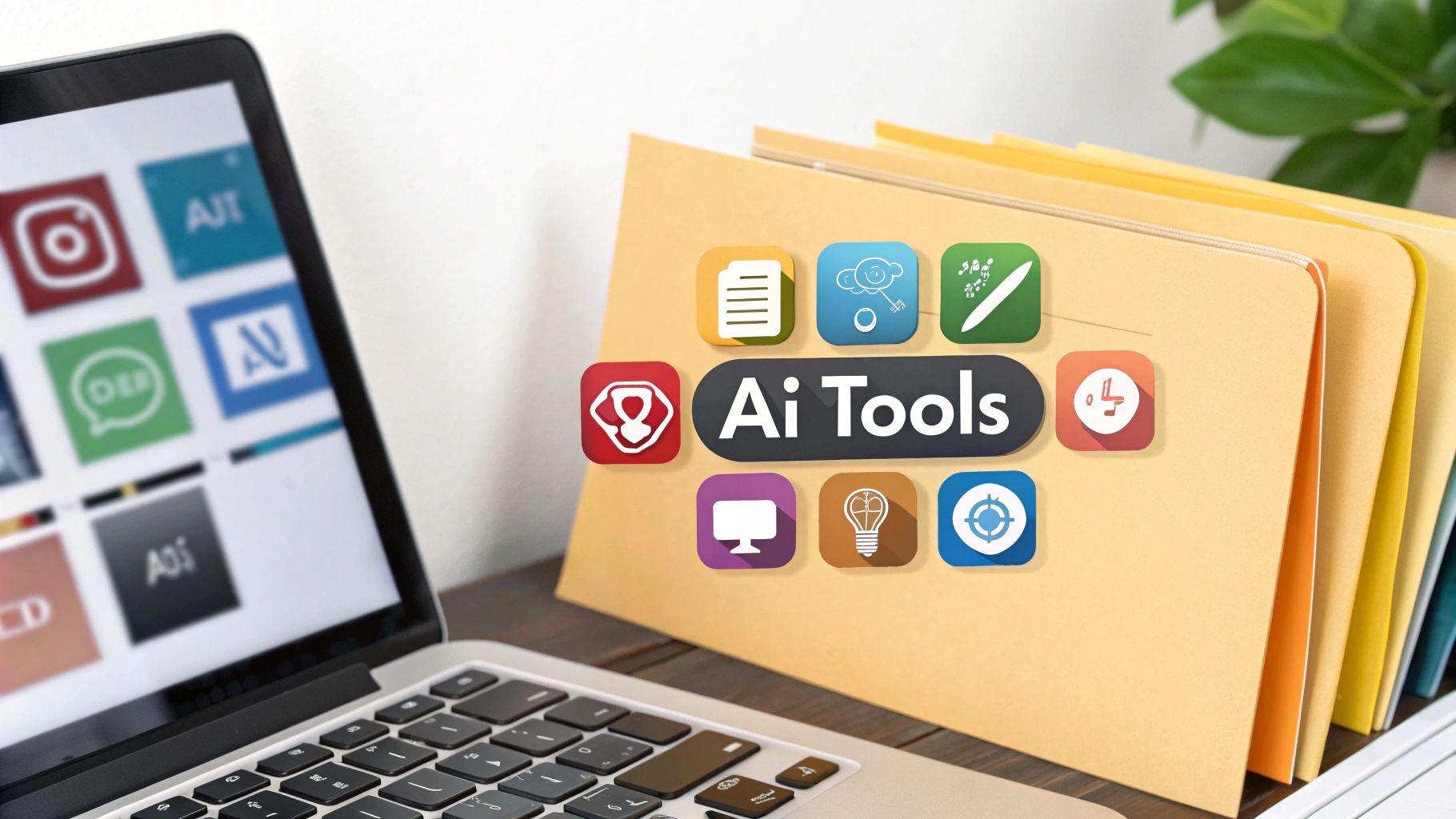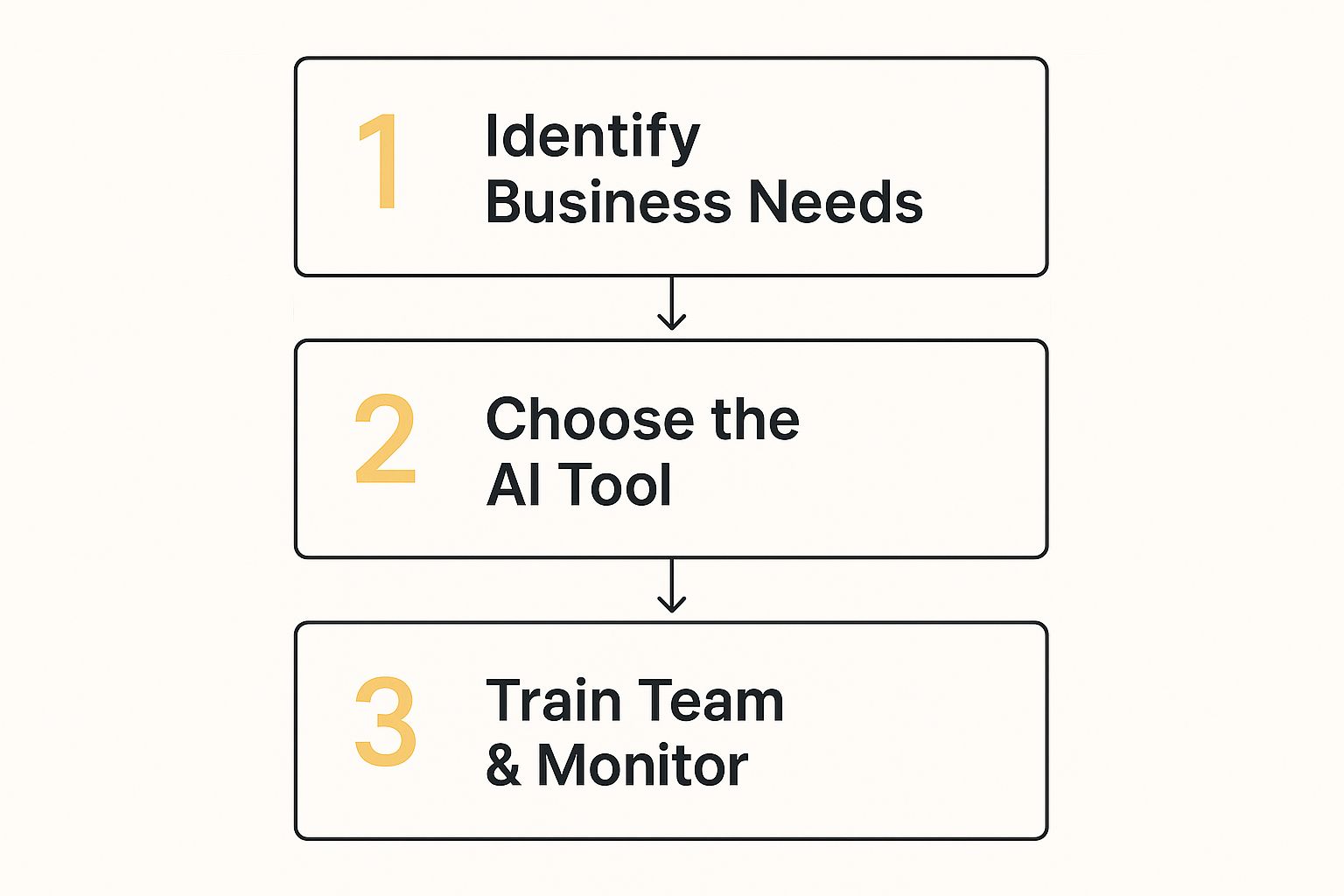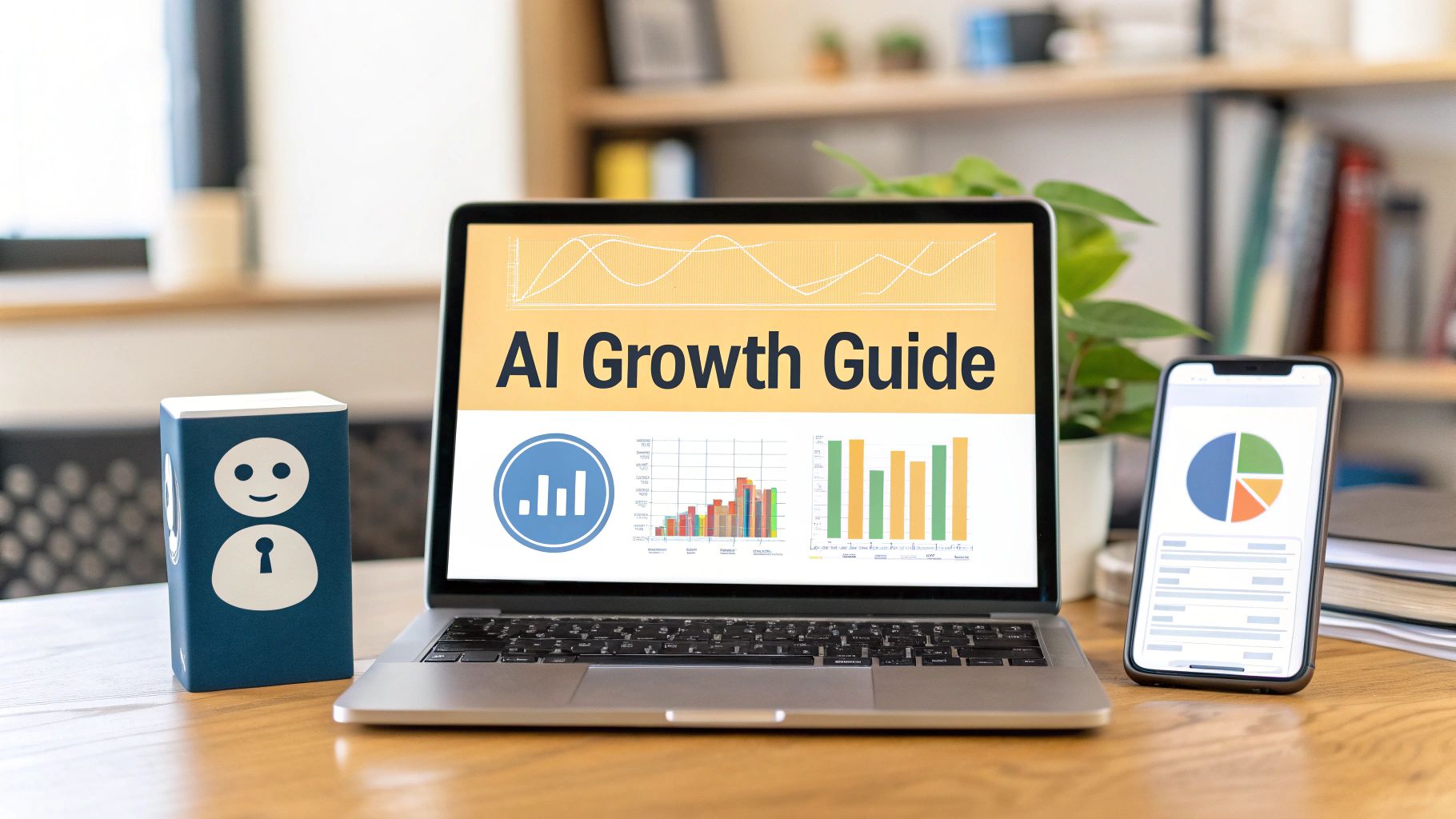AI solutions for small businesses aren't some sci-fi concept anymore. They're here, right now, offering real tools that can automate tedious tasks, make sense of your data, and create better experiences for your customers. Think of it as a force multiplier, giving smaller companies a serious shot at competing with the big players by working smarter, not just harder.
Why AI Is Your New Competitive Edge
Let's get one thing straight: artificial intelligence is no longer a luxury reserved for massive corporations with sprawling IT departments and bottomless budgets. Today, AI is more like a superpowered, affordable new team member that any entrepreneur can hire. It’s the ultimate leveler, giving you the tools to compete, grow, and even outmaneuver the established players in your market.
Think of AI not as some impossibly complex technology, but as a set of specialized assistants ready to handle the mind-numbing work that bogs you down. This frees you and your team up to focus on what actually moves the needle: strategy, innovation, and building real relationships with your customers. To get a better handle on how this works in practice, this piece on Artificial Intelligence in Marketing Explained is a great place to start.
The Shift From Niche to Necessary
Just a few years ago, adopting AI was a forward-thinking move. Now? It’s quickly becoming a fundamental part of running a successful business. This isn't just a fleeting trend; it’s a major operational shift, and it's all driven by data.
A recent global survey found that 75% of small and medium-sized businesses (SMBs) are actively putting money into AI technologies. For those who've already taken the plunge, the results speak for themselves: 91% report increased revenues, and 90% see more efficient operations.
That data tells a pretty clear story: your competitors are probably already using AI. They're automating their marketing, streamlining customer support, and making smarter decisions because they have the insights. Adopting the right AI tools is no longer about getting ahead—it's about not getting left behind.
To give you a clearer picture, here's a quick rundown of the major benefits.
Key AI Benefits for Small Business Growth
| Benefit Area | Description | Example AI Application |
|---|---|---|
| Increased Efficiency | Automates repetitive, time-consuming tasks, freeing up your team for more strategic work. | Using an AI chatbot to handle common customer service inquiries 24/7. |
| Enhanced Marketing | Creates highly targeted campaigns by analyzing customer data to predict behavior and preferences. | An AI-powered email tool that personalizes subject lines and content for each recipient. |
| Smarter Decisions | Analyzes complex datasets to uncover trends, forecast sales, and provide actionable insights. | A business intelligence dashboard that predicts inventory needs based on past sales and market trends. |
| Improved Customer Experience | Delivers personalized interactions and faster support, leading to higher satisfaction and loyalty. | An AI recommendation engine on an e-commerce site suggesting products based on browsing history. |
These examples are just the tip of the iceberg. The right AI can touch almost every part of your business, making it run smoother and grow faster.
How to Get Started Without a Technical Background
The beauty of modern AI solutions is that they're built for business owners, not data scientists. You don't need a computer science degree to get them working for you. The key is to start small and focus on your biggest headaches first.
We'll walk you through how to:
- Identify High-Impact Areas: Pinpoint which parts of your business are crying out for automation or smarter insights.
- Choose the Right Tools: Select user-friendly AI platforms that fit your budget and solve your specific problems.
- Implement and Measure: Weave these solutions into your daily workflow and track the impact on your bottom line.
Jumping into this new world can feel like a lot, which is why having a plan is so important. A good strategy ensures you invest in tools that solve real problems instead of just chasing the latest shiny object. For businesses looking for a clear path forward, professional AI consulting can provide a roadmap for successful implementation and growth.
Let's get started. This guide will set the stage for your business’s next chapter.
Understanding the Different Types of AI Tools

The world of AI can feel like a maze of technical jargon. But for a business owner, it’s much easier to think of AI solutions for small businesses as specialized members of your team, each hired to do a specific job exceptionally well. You don’t need to know the nuts and bolts of how they work, just what they can do for you.
Imagine hiring a marketing guru who never sleeps, crafting perfectly personalized email campaigns at 3 AM. Or an always-on support agent who instantly answers customer questions, day or night. Maybe you need a savvy operations manager to untangle your scheduling and inventory headaches. This is the practical reality of AI today.
To find the right fit for your business, it helps to group these tools into a few key categories. Let's break down the main types of AI that are making a real difference for small businesses right now.
Marketing and Sales AI
Think of this category as your lead-generation and deal-closing powerhouse. These AI tools are built to find potential customers, nurture their interest, and help your sales team convert them more effectively. They sift through data to spot patterns humans would miss, ensuring your message hits the right person at just the right time.
Here's what these tools often handle:
- Personalized Email Campaigns: Automatically sending emails with subject lines and content tailored to what each person has previously viewed or bought.
- Predictive Lead Scoring: Analyzing customer data to figure out which leads are most likely to buy, so your team can focus their energy where it counts.
- Content Creation: Generating ideas for blog posts, social media updates, and ad copy to help you fight writer's block and scale up your content.
- Social Media Management: Scheduling posts when your audience is most active and analyzing engagement to see what really connects with them.
These tools don’t replace your marketing strategy; they put it on steroids. They handle the repetitive, data-heavy lifting, freeing you up to focus on the big-picture creative work.
Customer Service AI
Excellent customer service is one of the biggest ways a small business can stand out. This type of AI ensures your customers feel heard and supported, even when you and your team are off the clock. These tools are your frontline defense, handling routine questions and giving customers instant answers.
In fact, 65% of customers now expect companies to adapt to their needs in real time. AI-powered customer service isn't just a "nice-to-have" anymore—it's a core part of meeting modern expectations.
The most common tool you'll see here is the AI chatbot. These aren't the clunky, frustrating bots of the past. Today's chatbots can:
- Answer frequently asked questions about store hours, shipping policies, or product details.
- Help customers track their orders or start a return.
- Pass complex issues to a human agent, along with the full conversation history so no one has to repeat themselves.
This kind of immediate support boosts customer satisfaction and dramatically cuts down on the simple, repetitive tickets your team has to handle manually.
Operations and Financial AI
This is your back-office brain, focused on making your business run smoother and more efficiently. These AI tools tackle the administrative, logistical, and financial tasks that are critical but can eat up a huge chunk of your time. By automating these processes, they reduce human error and give you clear insights into the health of your business.
Operations AI can help with things like:
- Smart Scheduling: Automating appointment bookings and staff schedules to avoid conflicts and make the most of everyone's time.
- Inventory Management: Forecasting demand to prevent running out of popular items or getting stuck with too much of something that isn't selling.
- Project Management: Automating task assignments and progress tracking to keep projects on schedule.
On the financial side, AI tools are changing the game for bookkeeping. They can automatically categorize expenses, send invoice reminders, and generate financial reports, giving you a crystal-clear view of your cash flow without you having to spend hours buried in spreadsheets.
The sheer number of tools out there can feel overwhelming at first. To get a better sense of what's available, you might want to explore a broader range of AI tools that cater to all sorts of business needs. The key is to start by identifying your biggest bottleneck and finding a specialized tool to solve that one problem first.
How AI Translates into Real-World ROI

It’s one thing to understand the different AI solutions for small businesses, but what really matters is seeing how they actually boost your bottom line. Let's be honest, investing in any new tool comes down to a clear return on investment (ROI), and AI delivers this in some pretty concrete ways.
Think about it this way: every repetitive, manual task your team tackles has a cost. It’s not just about the hours spent, but also the potential for human error. When AI steps in to handle those jobs, it isn't just a matter of convenience—it's about turning those saved hours and improved accuracy into real financial gains.
From Time Saved to Revenue Gained
The most immediate return you’ll see from AI comes from automation.
Imagine an e-commerce owner who spends five hours every week just answering the same handful of customer questions about shipping times and return policies. An AI chatbot can field those questions instantly, 24/7, freeing up those five hours. That’s 20 hours a month that can be poured back into product development, marketing, or customer outreach—activities that actually drive revenue.
But the financial impact goes deeper than just winning back time. AI can actively drive sales and cut wasteful spending, creating a powerful one-two punch for your profitability.
Here’s how that plays out in specific areas:
- Smarter Marketing Spend: AI analytics can predict which marketing channels will give you the best bang for your buck. This lets you put your budget where it counts instead of throwing money at ads that don't convert.
- Higher Customer Lifetime Value: By analyzing purchase history and behavior, AI helps you create personalized follow-up campaigns and offers that bring people back, turning one-time buyers into loyal fans.
- Reduced Operational Costs: AI-powered inventory management can forecast demand with scary accuracy. You can avoid overstocking on slow-moving items and make sure you never run out of best-sellers, which keeps your cash flow healthy.
Boosting Conversions and Customer Satisfaction
Happy customers spend more money and they come back. It’s that simple. One of the best things AI can do is create a standout customer experience, which has a direct line to your revenue. Digging into customer experience analytics with AI can uncover deep, data-driven insights that are almost impossible to find otherwise.
Take an online store, for example. An AI personalization engine can act like a virtual shopping assistant, analyzing a visitor's browsing habits in real-time. It can then recommend products they’re genuinely likely to love, seriously increasing the odds of a sale.
The new wave of AI tools has let small businesses all over the world see some remarkable gains. Case studies show small businesses using AI have seen up to 15 percent increases in average cart size, with conversion rates improving by as much as 260 percent.
This kind of personalization used to be reserved for giants like Amazon, but now it’s within reach for any small business. The result isn't just a single sale; it's about making customers feel understood, which is how you build real brand loyalty.
It’s a clear example of how putting money into the right AI automation tools can produce a measurable and significant return. The investment pays for itself through more sales, bigger orders, and happier, more loyal customers who keep coming back for more.
Your Practical Guide to Adopting AI
So, you're thinking about AI. Good. But let's be real—making the leap feels intimidating, especially when you're running a small business. It sounds expensive and complicated, like you'll need a team of data scientists on speed dial.
Forget all that. Bringing AI into your business isn't a massive tech overhaul. It’s more like hiring your first digital employee—a specialist you bring on to solve one specific, nagging problem. This guide will walk you through it, step-by-step, without the jargon or the overwhelm.
The absolute key is to start with a clear "why." So many businesses jump on the AI bandwagon without knowing where they're going, and they end up with a cool new tool that doesn't actually do anything useful. Let's not do that. Instead, we'll follow a simple three-phase plan.
This flowchart lays out the journey pretty clearly. It’s a deliberate process, not a sprint. You start by looking inward at your own operations, then carefully pick a tool, and finally, integrate it and see what happens.

As you can see, a smart AI adoption starts with a problem, moves to a solution, and ends with real results.
Phase 1: Find Your Biggest Bottleneck
Before you even think about looking at a single AI tool, look at your business. Where do things get stuck? What repetitive, soul-crushing tasks are eating up your team's time every single week? The best place to start with AI is always your biggest pain point, because solving it will give you the most immediate and satisfying return.
Grab a notepad and make a list. For most small businesses, it includes things like:
- Answering the same five customer questions over and over again via email.
- The endless back-and-forth of manually scheduling appointments and sending reminders.
- Staring at a blank screen trying to come up with social media posts every single day.
- Drowning in receipts and spreadsheets at the end of the month just to get your expenses categorized.
Got your list? Now, pick one. Just one. Don't try to solve everything at once. Your goal here is to get a focused, successful win. That first taste of success will build confidence and make it much easier to justify any future AI investments.
Phase 2: Research and Pick the Right Tool
Okay, now that you have a specific problem to solve, you can start hunting for the right tool. The market is flooded with user-friendly options built for people who aren’t tech experts, but you still need to be a savvy shopper.
It's not just about features. Research from Salesforce shows that 68% of customers believe that as AI advances, it becomes even more important for companies to be trustworthy. This means things like security and data privacy should be at the top of your checklist.
Think of it like test-driving a car. You want to see how it feels, if it has the features you need, and if the dealer seems honest. Here’s a simple framework to help you compare your options and cut through the marketing noise.
Choosing Your First AI Tool: A Comparison Framework
Finding the right AI tool can feel overwhelming with all the options out there. This table is designed to give you a straightforward way to evaluate potential tools, helping you focus on what really matters and spot potential issues before you commit.
| Evaluation Criteria | What to Look For | Potential Red Flags |
|---|---|---|
| Ease of Use | An intuitive interface, clear setup instructions, and a "no-code" or "low-code" approach. Can you figure it out without a manual? | A cluttered dashboard, confusing navigation, or documentation filled with technical jargon. |
| Integration | Does it play well with the software you already use, like your CRM, email platform, or e-commerce store? Look for native integrations or Zapier support. | A very short list of integrations. If it doesn't connect to your core tools, it will just create another silo. |
| Pricing | Clear, transparent pricing tiers. A free trial or a low-cost starter plan is a must so you can try it before you buy. | Hidden fees, overly complex usage-based pricing that's hard to predict, or no trial period. |
| Support | A good help center, video tutorials, and easy-to-reach human support (chat, email, or phone). | Poor user reviews that mention a lack of support. If you can't get help when you're stuck, the tool is useless. |
| Security | Clear policies on data privacy and compliance with regulations like GDPR. They should be upfront about how they protect your data. | Vague or missing information on their security practices. If they're not transparent, don't trust them with your data. |
Use this as your checklist when you're doing demos or running free trials. A tool might have amazing features, but if it fails on these basic points, it's probably not the right fit for your business.
Phase 3: Implement, Train, and Measure
You’ve picked your tool. Awesome. Now it's time to put it to work. This final phase is all about getting the AI solution plugged into your daily workflow, making sure your team is on board, and actually tracking its performance.
- Onboard Your Team: Don't just send out a login and hope for the best. Explain why you chose this tool and what specific problem it’s going to solve for everyone. Run a quick training session and create a simple one-page guide on how to use it.
- Start Small: Roll it out in a controlled way. If it’s a chatbot, start by having it answer only your top five most common questions. If it's a social media scheduler, start with just one platform. A small, successful launch is better than a big, messy one.
- Measure the Impact: You need to know if this thing is actually working. Define what success looks like before you start. Is it hours saved per week? A jump in leads? A better customer satisfaction score? Track these numbers before and after to prove your return on investment.
If you go through this process and find that off-the-shelf tools just can't handle your unique challenges, don't sweat it. That might be a sign it's time to explore something built just for you. Learning more about custom AI solutions can open your eyes to what’s possible when AI is designed specifically around your business.
Overcoming Common AI Adoption Hurdles

Let's get real for a minute and talk about what holds most small business owners back from diving into AI. If you’re worried about astronomical costs, needing a computer science degree, or just the sheer complexity of it all, you're not alone. Those are completely valid fears.
But here’s the thing: those fears are mostly based on an old, outdated idea of what AI is. The notion that it's only for giant corporations with entire floors of developers is a total myth. We’re now seeing a wave of affordable, intuitive, and genuinely user-friendly ai solutions for small businesses built for entrepreneurs like you.
Busting the Cost Myth
One of the biggest mental roadblocks is cost. When business owners hear "AI," their minds often jump to multi-million dollar investments. The reality couldn't be more different. Many of the most powerful AI tools run on a simple subscription model, with some plans starting for less than a few cups of coffee a month.
It's better to think in terms of ROI, not just expense. If an AI tool for social media costs you $30 a month but frees up 10 hours of your time, it's already paid for itself many times over. The goal isn't to spend a fortune; it's to invest a little to get a whole lot back in time and efficiency.
The most significant barrier is often not the price tag but the failure to recognize the value. The right AI tool is an investment in productivity, capable of closing the gap between small firms and their larger competitors.
This productivity gap is a documented reality. Small and medium-sized businesses in the United States make up over half the workforce but operate at just 47 percent of the productivity levels of large companies. This is often tied directly to lower AI adoption. It also points to a huge opportunity where AI can act as the great equalizer. You can learn more about how AI can boost SME productivity and what it means for the economy.
Demystifying Complexity and Skill Requirements
The second big fear? Complexity. Do you need to know how to code to use these tools? Absolutely not. The best AI tools for small businesses are built with "no-code" interfaces. If you can use platforms like Shopify, Mailchimp, or QuickBooks, you already have all the technical skills you need.
These platforms are designed to be incredibly approachable, usually featuring:
- Intuitive Dashboards: Clean, simple layouts that put the most important features right where you expect them.
- Guided Setup: Step-by-step onboarding that walks you through connecting your accounts and getting started.
- Extensive Support: Tons of video tutorials, help articles, and real humans on customer support to help if you get stuck.
Your business expertise is what truly matters here—far more than any technical knowledge. You know your customers, your industry, and your pain points. AI is just a tool you can use to apply that knowledge more effectively and at a much bigger scale. It's not another hurdle; it's the most powerful lever you have to level the playing field.
Frequently Asked Questions About AI for Small Businesses
Jumping into AI solutions for small businesses is exciting, but it almost always kicks up a bunch of questions. It's totally normal to go from "this sounds great" to "okay, but how does this actually work for me?" and wonder about the real-world details. This section is here to tackle those common hurdles head-on.
We've pulled together the most frequent questions we hear from entrepreneurs just like you. The goal is to clear away any confusion and give you the confidence to take the next step, whether you're worried about your budget, your tech skills, or just figuring out where on earth to begin.
Is AI Really Affordable for a Small Business Budget?
Absolutely. The idea that AI is only for giant corporations with massive R&D budgets is one of the biggest myths out there. The market today is packed with powerful, plug-and-play AI tools designed specifically for small business owners.
A lot of these tools run on a subscription model, with plans often starting at less than $50 per month. Some of the most useful AI apps for things like email marketing, social media scheduling, or basic customer service even offer generous free plans to get you started. This lets you test the waters without any financial risk.
The key is to stop thinking about it as a cost and start thinking about it as an investment.
If a simple AI tool saves you ten hours of admin work a month or helps bump your sales by even a few percentage points, it’s already paid for itself.
A smart way to start is with one single, high-impact but low-cost tool. Use it to prove the value to yourself and your team. Once you see the real benefits, you'll feel much more comfortable exploring other ways to bring AI into your business. It's all about minimizing risk while you learn.
Do I Need Technical Skills to Use AI Tools?
This is another huge misconception that holds so many business owners back. The vast majority of modern AI solutions for small businesses are built with user-friendly, no-code interfaces. The people making these tools know their customers are business owners, not software developers.
If you can find your way around platforms like Shopify, Mailchimp, or QuickBooks, you have all the technical skill you need. These AI-powered tools are designed with intuitive dashboards, guided setup wizards, and tons of support like video tutorials and help articles.
The focus here is on your business strategy, not your ability to write code. Your deep understanding of your customers, your industry, and your day-to-day challenges is way more valuable than any programming know-how. You bring the "what" and the "why," and the AI tool takes care of the "how."
Where Should I Start Using AI in My Business?
Honestly, the best place to start is almost always with your biggest headache. Take a second to think about the most repetitive, time-sucking, or just plain annoying tasks you deal with every day. That’s your "quick win" opportunity.
For most small businesses, the lowest-hanging fruit is in communication and marketing. These areas are usually full of routine tasks that are critical but don't need a lot of high-level strategic thought.
- Customer Communication: An AI chatbot can handle common questions 24/7—things like your business hours, shipping policies, or order status. This frees you or your team from answering the same emails over and over again.
- Marketing Automation: An AI-powered email marketing tool can run personalized campaigns to nurture leads automatically. It sends the right message at the right time without you lifting a finger.
- Administrative Work: AI can be a lifesaver here. Think automatically scheduling appointments, sending invoice reminders, or even transcribing the notes from your last meeting.
The goal is to pick one specific, nagging problem and find an AI tool built to solve it. Nailing that first implementation will not only boost your confidence but also show you firsthand just how powerful AI can be in practice.
How Do I Ensure a New AI Tool Works with My Software?
This is a super important question for making sure everything runs smoothly. Before you commit to any ai solutions for small businesses, you have to check out their integration capabilities. A powerful tool that can't talk to your other systems just creates more work.
Good AI providers are very open about this. They almost always have a dedicated "Integrations" or "App Marketplace" page on their website that lists every piece of software their tool connects with.
Look for tools that play nice with the core software you already depend on:
- Your CRM: Like HubSpot, Salesforce, or Zoho.
- Your E-commerce Platform: Such as Shopify, BigCommerce, or WooCommerce.
- Your Accounting Software: Like QuickBooks, Xero, or FreshBooks.
Even if there isn't a direct connection, don't give up just yet. Many modern tools can be linked together using intermediary platforms like Zapier or Make. These services act like universal translators, letting thousands of different apps share data automatically.
Making sure a new tool fits into your existing workflow is essential. It stops you from creating disconnected islands of data and ensures you're actually cutting down on manual work, not just moving it somewhere else.
Ready to stop wondering and start implementing? At Up North Media, we specialize in helping businesses like yours find and integrate the perfect AI solutions to accelerate growth and boost revenue. Schedule your free consultation today and let's build a smarter path forward for your business.
